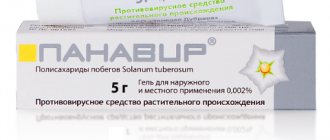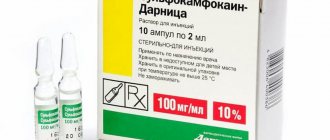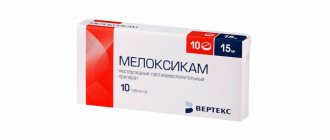Prednisolone Elfa Solution, ampoules, 3 pcs, 1 ml, 30 mg/ml, for injection
Indications for use
Parenteral administration. Acute allergic reactions; bronchial asthma and status asthmaticus; prevention or treatment of thyrotoxic reaction and thyrotoxic crisis; shock, incl. resistant to other therapy; myocardial infarction; acute adrenal insufficiency; liver cirrhosis, acute hepatitis, acute hepatic-renal failure; poisoning with cauterizing liquids (in order to reduce inflammation and prevent cicatricial contractions). Intra-articular administration: rheumatoid arthritis, spondyloarthritis, post-traumatic arthritis, osteoarthritis (in the presence of pronounced signs of joint inflammation, synovitis). Tablets. Systemic connective tissue diseases (systemic lupus erythematosus, scleroderma, periarteritis nodosa, dermatomyositis, rheumatoid arthritis); acute and chronic inflammatory diseases of the joints: gouty and psoriatic arthritis, osteoarthritis (including post-traumatic), polyarthritis, glenohumeral periarthritis, ankylosing spondylitis (Bechterew's disease), juvenile arthritis, Still's syndrome in adults, bursitis, nonspecific tenosynovitis, synovitis and epicondylitis ; rheumatic fever, acute rheumatic carditis; bronchial asthma; acute and chronic allergic diseases: allergic reactions to drugs and foods, serum sickness, urticaria, allergic rhinitis, angioedema, drug exanthema, hay fever; skin diseases: pemphigus, psoriasis, eczema, atopic dermatitis, diffuse neurodermatitis, contact dermatitis (affecting a large surface of the skin), toxicerma, seborrheic dermatitis, exfoliative dermatitis, toxic epidermal necrolysis (Lyell's syndrome), bullous dermatitis herpetiformis, malignant exudative erythema (syndrome) Stevens-Johnson); cerebral edema (including due to a brain tumor or associated with surgery, radiation therapy or head injury) after prior parenteral use; congenital adrenal hyperplasia; primary or secondary adrenal insufficiency (including the condition after removal of the adrenal glands); kidney diseases of autoimmune origin (including acute glomerulonephritis), nephrotic syndrome; subacute thyroiditis; diseases of the hematopoietic organs: agranulocytosis, panmyelopathy, autoimmune hemolytic anemia, congenital (erythroid) hypoplastic anemia, acute lympho- and myeloid leukemia, lymphogranulomatosis, multiple myeloma, thrombocytopenic purpura, secondary thrombocytopenia in adults, erythroblastopenia (erythrocytic anemia); lung diseases: acute alveolitis, pulmonary fibrosis, stage II–III sarcoidosis; tuberculous meningitis, pulmonary tuberculosis, aspiration pneumonia (in combination with specific chemotherapy); berylliosis, Loeffler's syndrome (not amenable to other therapy); lung cancer (in combination with cytostatics); multiple sclerosis; gastrointestinal diseases (to remove the patient from a critical condition): ulcerative colitis, Crohn's disease, local enteritis; hepatitis; prevention of transplant rejection; hypercalcemia due to cancer; nausea and vomiting during cytostatic therapy; allergic eye diseases: allergic corneal ulcers, allergic forms of conjunctivitis; inflammatory eye diseases: sympathetic ophthalmia, severe sluggish anterior and posterior uveitis, optic neuritis. Ointment: urticaria, atopic dermatitis, diffuse neurodermatitis, simple chronic lichen (limited neurodermatitis), eczema, seborrheic dermatitis, discoid lupus erythematosus, simple and allergic dermatitis, toxicerma, erythroderma, psoriasis, alopecia; epicondylitis, tenosynovitis, bursitis, glenohumeral periarthritis, keloid scars, sciatica. Eye drops: non-infectious inflammatory diseases of the anterior segment of the eye - iritis, iridocyclitis, uveitis, episcleritis, scleritis, conjunctivitis, parenchymal and discoid keratitis without damage to the corneal epithelium, allergic conjunctivitis, blepharo conjunctivitis, blepharitis, inflammatory processes after eye injuries and surgical interventions, sympathetic ophthalmia.
Pharmacological properties
Pharmacodynamics.
has anti-inflammatory, antiallergic, immunosuppressive, antishock and antitoxic effects. in relatively high doses suppresses the activity of fibroblasts, the synthesis of collagen, reticuloendothelium and connective tissue (inhibition of the proliferative phase of inflammation), delays synthesis and accelerates protein catabolism in muscle tissue, but increases its synthesis in the liver. The antiallergic and immunosuppressive properties of the drug are due to inhibition of the development of lymphoid tissue with its involution with long-term use, a decrease in the number of circulating T- and B-lymphocytes, inhibition of mast cell degranulation, and inhibition of antibody production. The antishock effect of the drug is due to an increase in the vascular response to endo- and exogenous vasoconstrictor substances, with restoration of the sensitivity of vascular receptors to catecholamines and an increase in their hypertensive effect, as well as a delay in the excretion of sodium and water from the body.
The antitoxic effect of the drug is associated with the stimulation of protein synthesis processes in the liver and the acceleration of inactivation of endogenous toxic metabolites and xenobiotics in it, as well as with an increase in the stability of cell membranes, including hepatocytes.
Enhances the deposition of glycogen in the liver and the synthesis of glucose from the products of protein metabolism. An increase in blood glucose levels activates the release of insulin. Suppresses the uptake of glucose by fat cells, which leads to activation of lipolysis. However, due to increased insulin secretion, lipogenesis is stimulated, which promotes fat accumulation. Reduces calcium absorption in the intestines, increases its leaching from bones and excretion by the kidneys. Suppresses the release of ACTH and β-lipotropin by the pituitary gland, and therefore, with long-term use, the drug can contribute to the development of functional insufficiency of the adrenal cortex.
The main factors limiting long-term prednisolone therapy are osteoporosis and Itsenko-Cushing syndrome. Prednisolone suppresses the secretion of thyroid-stimulating and follicle-stimulating hormones.
In high doses, it can increase the excitability of brain tissue and help lower the threshold for convulsive readiness.
Stimulates excessive secretion of hydrochloric acid and pepsin in the stomach, and therefore can cause the development of peptic ulcers.
Pharmacokinetics. When administered, it is absorbed into the blood quickly, but compared to reaching the maximum level in the blood, the pharmacological effect of the drug is significantly delayed and develops within 2–8 hours. In the blood plasma, most of prednisolone binds to transcortin (cortisol-binding globulin), and when the process is saturated, to albumin. With a decrease in protein synthesis, a decrease in the binding capacity of albumin is observed, which can lead to an increase in the free fraction of prednisolone and, as a consequence, the manifestation of its toxic effect when using normal therapeutic doses. T½ in adults is 2–4 hours, in children it is shorter. Metabolized by oxidation mainly in the liver, as well as in the kidneys, small intestine, and bronchi. Oxidized forms are glucuronidated or sulfated and excreted by the kidneys in the form of conjugates.
About 20% of prednisolone is excreted from the body unchanged by the kidneys, a small part is excreted in the bile.
In liver diseases, the metabolism of prednisolone slows down and the degree of its binding to plasma proteins decreases, which leads to an increase in T½ of the drug.
Side effects of Prednisolone
The incidence and severity of side effects of Prednisolone are influenced by the dose used, duration, method, as well as the ability to comply with the circadian rhythm of drug use.
Systemic use of the drug may cause:
- fluid and Na+ retention in the body, development of nitrogen deficiency , hypokalemic alkalosis, hypokalemia , glucosuria , hyperglycemia , weight gain;
- secondary hypocortisolism and hypopituitarism (especially if taking GCS coincides with periods of stress - injuries, surgeries, illnesses, etc.), growth suppression in children, Cushing's syndrome , menstrual irregularities, manifestations of LADA-diabetes mellitus , decreased tolerance to glucose, increased need for oral hypoglycemic agents and insulin in diabetics;
- increased blood pressure, CHF (or increased severity), hypercoagulation , ECG changes characteristic of hypokalemia thrombosis , spread of necrotic lesions and slowed scar formation with possible rupture of the heart muscle in patients with acute/subacute MI, obliterating endarteritis ;
- steroid myopathy , muscle weakness, avascular necrosis of the head of the humerus and femur, loss of muscle mass, compression fracture of the spine and pathological fractures of long bones, osteoporosis ;
- ulcerative esophagitis , flatulence , digestive disorders, vomiting, nausea, increased appetite, development a steroid ulcer with possible complications in the form of its perforation and bleeding from the ulcer, pancreatitis ;
- hypo- or hyperpigmentation of the skin, atrophy of the skin and/or subcutaneous tissue , the appearance of acne, atrophic stripes, abscesses , delayed wound healing, ecchymosis , petechiae , thinning of the skin, increased sweating, erythema ;
- mental disorders (possible hallucinations, delirium , euphoria , depression ), pseudotumor cerebri syndrome (most often develops in children when the dose is reduced too quickly and manifests itself in the form of decreased visual acuity, headaches, diplopia), sleep disorders, vertigo , dizziness, headache , development of cataracts with localization of opacity in the back of the lens, ocular hypertension (there is a possibility of damage to the optic nerve ), steroid exophthalmos , glaucoma , sudden blindness (with the introduction of a d/i solution into the area of the nasal sinuses, head and neck);
- hypersensitivity reactions (both local and generalized);
- general weakness;
- fainting states.
Effects of application on the skin:
- telangiectasia;
- purpura;
- steroid acne;
- burning, irritation, dryness and itching of the skin.
When applied to large surfaces of the skin and/or with prolonged use of the ointment, systemic effects develop, hypertrichosis , atrophic changes and secondary infection of the skin .
Treatment with eye drops may be accompanied by ocular hypertension , damage to the optic nerve , impaired visual acuity/narrowing of the visual field, increased likelihood of perforation of the cornea , and the development of cataracts with clouding localized in the posterior part of the lens. In rare cases, or viral eye disease spread .
Signs of withdrawal syndrome
One of the consequences of using GCS may be “withdrawal syndrome” . Its severity depends on the functional state of the adrenal cortex . In mild cases, after stopping treatment with Prednisolone, malaise, weakness, fatigue, muscle pain, loss of appetite, hyperthermia, and exacerbation of the underlying disease are possible.
In severe cases, the patient may develop a hypoadrenal crisis , which is accompanied by vomiting, convulsions , and collapse . death from acute cardiovascular failure occurs in a short time .
Application
Mixing and simultaneous use of prednisolone with other drugs in the same infusion system or syringe is not allowed!
The drug is intended for intravenous, intramuscular or intra-articular administration. The dose of prednisolone depends on the severity of the disease.
For the treatment of adults, the daily dose is 4–60 mg IV or IM.
For children, the drug should be prescribed intramuscularly (deep into the gluteal muscle) strictly according to indications and under the supervision of a physician: children aged 6-12 years - 25 mg/day, over 12 years - 25-50 mg/day. The duration of use and the number of injections of the drug are determined individually.
For Addison's disease, the daily dose for adults is 4–60 mg IV or IM.
In severe forms of ulcerative colitis - 8-12 ml/day (240-360 mg prednisolone) for 5-6 days, in severe forms of Crohn's disease - 10-13 ml/day (300-390 mg prednisolone) for 5–7 days.
In emergency situations, prednisolone should be administered intravenously slowly (over about 3 minutes) or drip at a dose of 30–60 mg. If intravenous infusion is difficult, administer the drug intramuscularly, deeply. With this method of administration, the effect develops more slowly. If necessary, the drug is re-administered intravenously or intramuscularly at a dose of 30–60 mg every 20–30 minutes.
In some cases, an increase in the indicated dose is allowed; this is decided by the doctor individually in each specific case.
For adults, the dose of intra-articular prednisolone is 30 mg for large joints, 10-25 mg for medium-sized joints and 5-10 mg for small joints. The drug should be administered every 3 days. The course of treatment is up to 3 weeks.
Compound
Composition of Prednisolone in ampoules: active substance at a concentration of 30 mg/ml, as well as sodium pyrosulfate (additive E223), disodium edetate, nicotinamide, sodium hydroxide, water for injection.
Composition of Prednisolone tablets: 1 or 5 mg of active substance, colloidal silicon dioxide, magnesium stearate, stearic acid, starch (potato and corn), talc, lactose monohydrate.
Prednisolone ointment contains 0.05 g of active substance, soft white paraffin, glycerin, stearic acid, methyl and propyl parahydroxybenzoate, Cremophor A25 and A6, purified water.
Overdose
In case of overdose, nausea, vomiting, bradycardia, arrhythmia, increased symptoms of heart failure, cardiac arrest, hypokalemia, increased blood pressure, convulsions, hyperglycemia, thromboembolism, acute psychosis, dizziness, headache are possible, symptoms of hypercorticism may develop: weight gain, edema development , hypertension, glucosuria, hypokalemia. in children with an overdose, suppression of the hypothalamic-pituitary-adrenal system, Cushing's syndrome, decreased excretion of growth hormone, and increased intracranial pressure is possible.
Treatment: discontinuation of the drug, symptomatic therapy, and, if necessary, correction of electrolyte balance. There is no specific antidote.
Interactions
With the simultaneous use of prednisolone with other drugs, it is possible:
- with thyroid hormones, inducers of liver enzymes, in particular with barbiturates, phenytoin, pyrimidone, carbamazepine, rifampicin: weakening of the effects of prednisolone due to an increase in its systemic clearance;
- with estrogens (including oral contraceptives that contain estrogen), cyclosporine, CYP 3A4 inhibitors, in particular erythromycin, clarithromycin, ketoconazole, diltiazem, aprepitant, itraconazole, oleandomycin: increased therapeutic and toxic effects of prednisolone;
- with antacids: decreased absorption of prednisolone;
- with salicylic acid derivatives and other NSAIDs: increased likelihood of ulceration of the gastric mucosa; prednisolone reduces the level of salicylic acid derivatives in the blood serum, increasing their renal clearance; the drug increases the risk of developing hepatotoxic reactions of paracetamol due to the induction of liver enzymes and the formation of its toxic metabolite;
- with cardiac glycosides: increased toxicity of the latter, and as a result of the resulting hypokalemia - increased risk of developing arrhythmias;
- with hypoglycemic agents: suppression of the hypoglycemic effect of oral hypoglycemic agents and insulin;
- with antihypertensive drugs: decreased effectiveness of the latter;
- with tricyclic antidepressants: increased signs of depression caused by the use of prednisolone and increased intraocular pressure;
- with immunosuppressants: increased risk of developing infections and lymphoma or other lymphoproliferative disorders associated with the Epstein-Barr virus;
- with diuretics, laxatives, amphotericin B: increased risk of hypokalemia; prednisolone increases the risk of developing osteoporosis when used simultaneously with amphotericin and carbonic anhydrase inhibitors;
- with M-anticholinergic drugs, antihistamines, nitrates: increased intraocular pressure and decreased effectiveness of antihistamines;
- with antipsychotics, carbutamide, azathioprine: increased risk of developing cataracts;
- with estrogens, anabolic drugs, oral contraceptives: manifestations of hirsutism and acne;
- with live antiviral vaccines and against the background of other types of immunization: increased risk of viral activation and development of infections;
- with muscle relaxants against the background of hypokalemia: increased severity and duration of muscle blockade during the use of muscle relaxants;
- with anticholinesterase drugs: the occurrence of muscle weakness in patients with myasthenia gravis (especially in patients with myasthenia gravis);
- with mitotane and other inhibitors of adrenal cortex function: may cause an increase in the dose of the drug;
- with antiemetics: increased antiemetic effect;
- with isoniazid, mexiletine, praziquantel: decrease in their concentrations in blood plasma;
- with somatropin (in high doses): decreased effect of the latter;
- with fluoroquinolones: tendon damage;
- with cyclosporine: cases of seizures have been reported. Because coadministration of these drugs causes mutual inhibition of metabolism, it is likely that seizures and other side effects associated with the use of each drug as monotherapy may occur more frequently when used in combination. Concomitant use may cause an increase in the concentration of other drugs in the blood plasma.
With long-term therapy, prednisolone increases folic acid levels.
The drug reduces the effect of vitamin D on the absorption of Ca2+ in the intestinal cavity.
Incompatibility. Prednisolone should not be mixed or used simultaneously with other drugs in the same infusion system or in the same syringe.
When mixing a solution of prednisolone with heparin, a precipitate forms.
Incompatible with aerosols of sympathomimetic drugs for the treatment of asthma in children (risk of developing respiratory paralysis).
What can replace Prednisolone?
Analogues in composition for dosage forms for systemic use: Prednisolone Nycomed (in ampoules), Prednisolone Nycomed in tablets, Prednisolone Bufus (solution), Medopred (solution), Prednisol (solution).
Similar drugs with a similar mechanism of action: Betamethasone , Hydrocortisone , Dexazone , Dexamed , Dexamethasone , Kenalog , Lemod , Medrol , Deltasone , Metipred , Rektodelt , Triamcinolone , Flosterone .
Ointment analogues: Prednisolone-Ferein , Hydrocortisone .
Analogs of eye drops: Hydrocortisone , Dexamethasone , Dexapos , Maxidex , Oftan Dexamethasone , Dexoftan , Prenacid , Dexamethasonelong , Ozurdex .
Note!
Description of the drug Prednisolone-Darnitsa solution d/in. 30mg/ml amp. 1ml No. 3 on this page is a simplified author’s version of the apteka911 website, created on the basis of the instructions for use.
Before purchasing or using the drug, you should consult your doctor and read the manufacturer's original instructions (attached to each package of the drug). Information about the drug is provided for informational purposes only and should not be used as a guide to self-medication. Only a doctor can decide to prescribe the drug, as well as determine the dose and methods of its use.
Reviews of Prednisolone
Reviews of Prednisolone in tablets and injections are quite contradictory: on the one hand, the medicine is very effective, on the other, it has a wide range of side effects and, with long-term use, causes withdrawal syndrome . Also, some people using the drug note that the injection is painful.
However, it is injections for children and adults that often make it possible to very quickly stop the pathological process and even save lives.
To reduce the risk of side effects and their severity, if long-term use of Prednisolone is necessary, it is very important to follow the following rules:
- the drug is prescribed in situations where the therapeutic effect is not achieved when using less active agents (with the exception of life-threatening pathologies of the patient, adrenogenital syndrome , hypocortisolism );
- treatment begins with the minimum effective dose, which is increased if necessary until the desired result is obtained;
- the dosage is selected individually depending more on the patient’s response to therapy and the characteristics of the disease than on body weight and age;
- after obtaining the desired result, the dose is gradually reduced to the lowest at which the achieved effect is maintained;
- The drug should be taken taking into account the circadian rhythm;
- After the patient’s condition has stabilized, it is advisable to transfer him to alternative therapy.
As for dosage forms for topical use, they are mostly positive. At the same time, patients using eye drops and ointment report virtually no adverse reactions.





